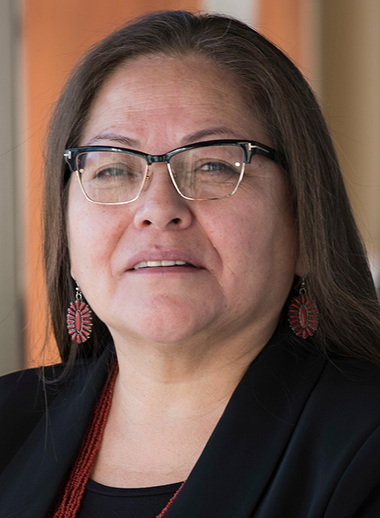The First Americans in Minority Health and Health Disparities Research
As we celebrate Native American Heritage Month this year, we are recognizing the First American researchers in fields of minority health and health disparities, whose career trajectories have been shaped by the NIMHD-sponsored Loan Repayment Program (LRP) and subsequent research program grants. Meet Teresa Brockie, PhD, MSN, RN, FAAN.

Dr. Teresa Brockie
Dr. Brockie is an assistant professor at the Johns Hopkins University School of Nursing and holds a joint appointment at the Johns Hopkins Bloomberg School of Public Health in the Center for American Indian Health, in Baltimore, Maryland. She represents the Frozen Clan as a member of the White Clay Nation (A’ananin) from the Fort Belknap Reservation in rural Montana. She grew up in Hays, on the southern end of the reservation. She uses her lived experience, A'aniiih culture, and stories passed down from her mother and grandmother to inform her research with Indigenous communities experiencing generations of health disparities.
Dr. Brockie’s research focuses on achieving health equity through community-based prevention interventions to overcome suicide, trauma, and adverse childhood experiences. Her life goal has been to improve health and health care for Native Americans, first as a public health nurse and now as an Indigenous scientist and scholar.
Dr. Brockie’s inspiration to work on addressing minority health and health disparities stems from seeing the culturally sensitive care provided by the Native American nurses on her reservation. She embraces the A'aniiih culture and way of life and leverages tribal strengths in her approach to working with Native American communities, whereby she aims to elevate Indigenous health and abate disparities.
Q & A with Dr. Teresa Brockie
How is your research impacting public health?
My most significant scientific contributions focus on Native American children; adolescent and young adult mental health-related outcomes, including childhood adversity; suicide risk and protective factors; and historical trauma. Using collaborative approaches that emphasize cultural strengths, my research concentrates on high-risk, reservation-based Native American youth, who suffer the highest rates of suicide, substance use, and related behavioral and mental health consequences of any racial or ethnic group in the United States.
My work is focused on alleviating the effects of high rates of trauma, and associated suicide, and substance use through the following projects:
1.) Wa'Kan Ye'Zah (Little Holy One): Enhancing caregivers' and children's well-being through an evidence-based and culturally informed prevention intervention (1R01MH115840-01A1).
We worked with communities to design an intergenerational intervention to reduce symptoms of historical trauma and everyday stress among parents/caregivers and improve parenting and childrens’ emotional and behavioral developmental outcomes to reduce their future risk for suicide and substance use.
2.) Social Networks among Native American Caregivers Participating in an Evidence-Based and Culturally Informed Intergenerational Intervention (3R01MH115840-02S1).
The goal of this study is to understand opioid use, suicide, and social network characteristics by analyzing social networks of Fort Peck Assiniboine and Sioux parents/caregivers.
3.) Expanding Celebrating Life Suicide Surveillance and Case Management Program to the Fort Peck Indian Reservation (3U19MH113136-02S1).
We are working to design and implement a suicide surveillance and case management system for a Northern Plains reservation context that was proven effective in the White Mountain Apache Tribe.
How has the Loan Repayment Program (LRP) impacted your career?
When I began my doctoral program, the annual income in my community was $11,000, and the tuition at the Johns Hopkins School of Nursing was $54,000 per year. Despite financial concerns, I knew programs such as the NIH Loan Repayment Program might be an option following completion of my degree. The LRP has not only alleviated financial debt and stress; it has enabled me to move my work forward and make a positive impact for Native American communities.
What was your motivation in becoming an independent research investigator?
Native Americans are historically overlooked, and to many, they are invisible. Devastating trends seen across the United States have motivated me to make things better. In 2020, approximately 30-40% of the Navajo Nation lacks access to electricity or running water, and 50-80% of Native Americans in the Great Plains Area live below the poverty level. U.S. counties that include reservations are consistently ranked as having the most impoverished and unhealthiest residents. Indigenous Peoples have inherent strength and resilience. The cultural strength of tribal identity, including language, traditions, ceremonies, and stories—like those told by my mother and grandmother—cannot be overstated. My community and its life-affirming values motivate and sustain me as an Indigenous nurse researcher.
Is there a particular challenge you had to overcome in your career, and what advice would you give to the next generation?
Our grandmothers and grandfathers demonstrated strength and resilience, and from them we have learned so much about not giving up. Even so, there are many challenges that exist when one enters systems that have been built to favor one group over another. I would advise the next generation to join me in advocating, educating, and engaging in these systems to eliminate barriers and improve health outcomes for all groups of people.
What is your vision for health equity in this new decade?
Health equity can be achieved when we start by supporting those with the greatest needs and allocating resources appropriately. Disaggregating data is imperative for achieving this goal. We also need to dismantle the problematic social concept of race, as it hides within-group differences. Overall, we must acknowledge and address factors that drive systemic inequities. Such factors are not randomly distributed, as we can see through unequal distribution of social determinants of health. Therefore, I will continue focusing my research and scholarship on those with the greatest need, from a position of equity and social justice.
Page updated Dec. 24, 2024

















